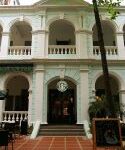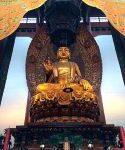You might recognize this city of 12 million if I told you it once went under the name of Canton; many émigrés from this part of China have made Cantonese food (or the variant of it in the U.S.) the standard that most Americans think of as “Chinese food.”
It occurred to me when we arrived here Saturday night that we’re going in reverse, not only to the way I originally entered China, but for the way many foreigners (especially oceangoing devils) came to the Middle Kingdom — from Hong Kong or the China Sea. Under the Qing dynasty, foreigners were kept away from the political capital, Beijing, and relegated to doing commerce with south China. In the 1790s, emperor Qian Long told the British minister who wanted to establish diplomatic relations with China that Britain had nothing the Chinese could possibly want. And that was more or less true until the British sent “foreign mud”(opium) to China, and it caught on like an addiction (which it was). The emperor in the late 1830s attempted to interdict (look that one up) the Opium trade, and the Opium War began.
It ended in 1842, I believe, with the Chinese ceding the right of Englishmen to trade with five port cities in China. If you go to Beijing, the stele (look that one up, too) describing the Communist history of modern China begins with the Opium War, beginning the century of foreign oppression that the Chinese see as a modern anomaly.
Canton has been a trading point on the “maritime Silk Road” for centuries — down till today. The Canton trade fair was one of China’s few links with the outside world until Deng Xiaoping “opened” four special economic zones to Western economic influence in the early 80s. Guangzhou has boomed since then.

We’re staying at the White Swan Hotel, which was China’s first five-star hotel. For me it deserves that ranking because of its location. The White Swan is on Shamian Island, which was where foreigners repaired after winning the Opium War. The former German consulate is across the street, and Christ Church has been standing here since 1865. There are lots of old colonial buildings being restored because Guangzhou is hosting the Asian games this year, and the government is spicing up the city (Shanghai, I meant to mention, expects to have 800,000 visitors a day from May to October at its expo; I’m glad I was there in January!)
at the White Swan Hotel, which was China’s first five-star hotel. For me it deserves that ranking because of its location. The White Swan is on Shamian Island, which was where foreigners repaired after winning the Opium War. The former German consulate is across the street, and Christ Church has been standing here since 1865. There are lots of old colonial buildings being restored because Guangzhou is hosting the Asian games this year, and the government is spicing up the city (Shanghai, I meant to mention, expects to have 800,000 visitors a day from May to October at its expo; I’m glad I was there in January!)
We’ve essentially had two days of sightseeing. In Hangzhou, my roommate (an economist, who used to be a smokejumper in Montana) and I rented a car and went to the Lingyin Temple, which had some wondrous carvings in a cliff along the creek that dated from the Yuan dynasty. The temple itself had the largest Buddha made of wood (or something like that), that helped me understand why Chinese are so fond of Hangzhou. From the temple we went to the tomb of a famous general (who fought for the southern Song
a cliff along the creek that dated from the Yuan dynasty. The temple itself had the largest Buddha made of wood (or something like that), that helped me understand why Chinese are so fond of Hangzhou. From the temple we went to the tomb of a famous general (who fought for the southern Song  about a millennium ago). I discovered it with a friend from Taiwan, who cried because the general was a hero: he had carved “give me back my country” on his back; his story is memorized on Taiwan, and his patriotism is recognized on the mainland.
about a millennium ago). I discovered it with a friend from Taiwan, who cried because the general was a hero: he had carved “give me back my country” on his back; his story is memorized on Taiwan, and his patriotism is recognized on the mainland.
The tomb was next to West Lake, and we had a chance to walk through the renowned gardens. Hangzhou’s commercial importance waned after the city was destroyed during the 19th century Taiping rebellion, but it is regaining importance with Alibaba, and another domestic business, Wanxiang group. Wanxiang owns a number of auto part suppliers, including one in Aurora, Ill. The CEO of the North American group is the founder’s son.
In Guangzhou, where it’s been “cool for Guangzhou” we went yesterday morning to a university complex, which houses 15 campuses and around 150,000 students on the outskirts of town. It’s nearly exam time here, and there was not a vacant seat in the library. Left on our own in the afternoon, a number of us went to a temple that was so authentic (albeit recreated after the Cultural Revolution of the 1960s left it in ashes) that we paid no admission! A first.
 Today was back to business, literally. We spent the morning on the main campus of an early 20th century university, named for Sun Yat-sen, the father of modern China. We met with the business school, which has 6,000 of the 80,000 students on the school’s four campuses; it is one of the top four schools in China. The business school dates from 1985 (note that date) and runs a variety of programs, including an international MBA that is taught in English and commands a premium from students (around $25,000 tuition) and from the faculty, who get paid 1.5X their salary for teaching in English. 98% of the graduates (MBA) have jobs before graduation, and earn about the cost of their tuition.
Today was back to business, literally. We spent the morning on the main campus of an early 20th century university, named for Sun Yat-sen, the father of modern China. We met with the business school, which has 6,000 of the 80,000 students on the school’s four campuses; it is one of the top four schools in China. The business school dates from 1985 (note that date) and runs a variety of programs, including an international MBA that is taught in English and commands a premium from students (around $25,000 tuition) and from the faculty, who get paid 1.5X their salary for teaching in English. 98% of the graduates (MBA) have jobs before graduation, and earn about the cost of their tuition.
It seemed appropriate to me that after our “class” and lunch with professors, we toured a brewery, whose chief officer is a woman engineer. She told us that Zhujiang brewery started in 1985 (told you to watch that date), but is now (as a State-Owned Enterprise) the major brewer (70% market share in Guangdong province — about 60 million people), with about 8 plants in the region and 6,000 employees. The goal is to develop an internationally recognized brand — and in 25 years, sales have increased 30X, but since we talked with an engineer rather than a marketer, we didn’t learn much about creating an international brand. Like the tour of the Budweiser plant (an apt comparison, since Inbev-Anheuser Busch is a 30% stockholder in Zhujiang), the path goes through a museum on beer history into a tasting room.
Needless to say, we’ve had some great Cantonese food!